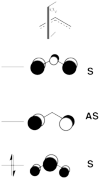VBTutorial2
Révision datée du 29 mai 2012 à 12:15 par Benoit (discussion | contributions) (→Exercise 3 : Resonance energy of Benzene)
How to modify this page :
- first : log in (top right of this page) ;
- click on [edit] (far right) to edit a section of the page ;
- write your text directly in the wiki page, and click on the "Save page" button (bottom left) to save your modifications
Pictures : how to insert a picture in your text
See also this page for an introduction to the basics of the wiki syntax
To the Tutors
Sason remarks and prospective 2 hours talk +
Philippe's remark on the initially proposed tutorial. are included in bold.
Qualitative
- Exercices from The Book ... >PCH< (30')
Computational
- Allyl cation : VB 3 configuration (3rd configuration has a large weight).
- Benzene : question about basis of covelent structures (paper exercise, then xmvb zith str=cov), then all ionics.
- Ozone : paper exercise ; expand MO wf in VB basis, wieghts of biradical with HF, compute with XMVB (VBSCF, BOVB)
- Benzyl radical with most spin alternant determinants (2 determinants) (p228 of The Book) show spin location. Objection : this uses Heisenberg spin hamiltonian theory, a topic that we do not teach.
(trash: * O2 paradigm : compute singlet - triplet gap : too hard
- H2O lone pairs : compute H2O+ states (2 configurations mixing) Objection : did you try to do that ? If we let the orbitals optimize themselves, I guess we will converge to the MO solution with weight 1.0, the other structure with weigt 0.0. The H2O+ states would better be done as qualitative exercises.)
Exercices
Remark : in all the following exercises, <math>\pi</math> the system will be taken as active, and the <math>\sigma</math> system as inactive. In all VB calculations, the <math>\sigma</math> orbitals shall be described by MOs delocalized onto the whole molecule.
Exercise 1 : The allyl radical and cation
Subject
Here is a image example
Th
To do
Access to files :
Exercise 2 : Radical character of ozone
- Paper exercice :
- Propose a complete basis of non-redondant VB structures for the ozone molecule. Based on your chemical knowledge, propose a selection subset of the most chemically meaningful structures.
- Use the HuLis software to retrieve the Hückel MOs for ozone. Write a single-determinant MO wave function based on Hückel orbitals. Develop it into the basis of atomic orbitals, to get an expression in terms of VB structures.
- Compute by hand the weights of the different structures (neglecting all overlaps for simplicity). What is the radical character of ozone according to simple MO theory ?
- Computer exercise :
- Compute a VBSCF wave function for ozone (6-31G* basis set) using your selected set of structures (question 1.1). Compute a VBSCF wave function including the complete set of VB structures, using the "str=all" keyword. Compare the weights and energies for both wave functions to validate your selection of structures.
- Compute a BOVB wave function for ozone which include only your selected set of most chemically meaningful structures (use the guess orbitals obtained at the VBSCF level).
- Compare the weights obtained at the VBSCF and BOVB level. Compare the BOVB diradical weight to the value predicted by simple MO theory.
Exercise 3 : Resonance energy of Benzene
To be written...
